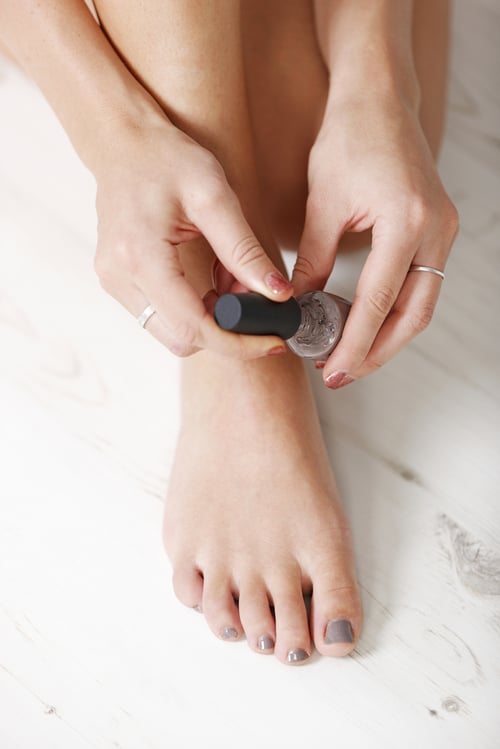
Toe fungus is a common problem that affects millions of Americans. It can cause discomfort, embarrassment, and even pain if left untreated.
“Toe fungus comes from yeast or mold. It’s unclear why people get toe fungus,” explains Kevin Springer, podiatrist, and assistant professor, at Ohio State Wexner Medical Center. “The most common places where toe fungus develops are the big toe and the fifth toe because they are in closest contact with your shoes.”
Whether it's nail fungus or skin fungus between the toes, understanding the different types, causes, symptoms, and treatment options is essential for effective management.
“It’s a fairly common problem that time, alone, won’t heal. If you want to eliminate the fungus, you’ll need to take medication or apply medicine directly to your nails. Either way, seeing your toenails return to normal usually takes nine months to a year, sometimes longer,” writes Springer.
Two Main Types of Toe Fungus
There are two primary types of toe fungus, each with its preferred hangout spot on your foot.
“Nail fungus is also called onychomycosis (on-ih-koh-my-KOH-sis). When fungus infects the areas between your toes and the skin of your feet, it's called athlete's foot (tinea pedis),” says the Mayo Clinic.
- Onychomycosis (Nail Fungus): This is the most common type of toe fungus, affecting the toenails. It can cause the nails to become thick, discolored, and brittle.
- Tinea Pedis (Athlete's Foot): This fungal infection affects the skin between the toes and on the soles of the feet. It can cause itching, burning, and cracking of the skin.
The Centers for Disease Control and Prevention (CDC) says that onychomycosis is very common and may affect up to 14 percent of the general population.
Tinea pedis, according to a paper published in 2023 in Drugs in Context, is one of the most common, if not the most common, superficial fungal infections of the skin after puberty, and its prevalence is increasing.
“Many people will have athlete's foot at some point in their lives,” says the National Library of Medicine overview on the topic, with some estimates that 70 percent of the population will suffer from tinea pedis at some point in their lives.
What Causes Toe Fungus?
Several factors can contribute to developing toe fungus, including:
- Moisture: Fungus thrives in damp environments. Sweaty feet trapped in socks and shoes for long periods create a fungal breeding ground.
- Public Places: Sharing locker rooms, showers, or swimming pools can increase your risk of exposure to fungal spores.
- Tight-fitting Shoes: Shoes that don't allow proper ventilation can trap moisture and create a fungus-friendly environment.
- Weak Immune System: A compromised immune system makes you more susceptible to fungal infections.
- Certain Medical Conditions: People with diabetes, circulatory problems, or skin conditions like psoriasis are at higher risk.
- Sharing Personal Items: Sharing personal items like towels or nail clippers with an infected person can cause toe fungus to spread.
“If you get a pedicure, it’s best not to have your cuticles cut or pushed back. That can allow fungus and bacteria to get behind the nail. Before getting the pedicure, ask to make sure the nail files and other instruments are sterilized between customers,” advises Springer. “Also, never share shoes. Fungus lives inside everyone’s shoes where it’s dark and damp, the perfect environment for fungus to grow.”
Symptoms of Toe Fungus
Both types of toe fungus can cause itching, burning, and discomfort. However, they have some distinct symptoms:
- Onychomycosis (nail fungus):
- Thickened, discolored (yellow, brown, or white), crumbly, or brittle nails.
- Nails that separate from the nail bed or distorted nail shape.
- Foul odor from the infected nails.
- Tinea Pedis (athlete’s foot):
- Itching, burning, inflammation, or stinging between the toes or on the soles of the feet.
- Red, scaly, cracked, or peeling skin.
- Blisters or ulcers in severe cases.
- Foul odor from the infected area.
How Serious is Toe Fungus?
While not life-threatening, toe fungus can be uncomfortable and affect your quality of life. Additionally, untreated toenail fungus can worsen and potentially lead to secondary bacterial infections.
Severe cases of skin fungus may result in open sores or ulcers, increasing the risk of complications, especially in individuals with diabetes or compromised immune systems.
So, your best course of action is to get your potential toe fungus diagnosed by a podiatrist or your healthcare provider.
How Toe Fungus is Diagnosed
If you suspect you are suffering from toe fungus, it's important to see a podiatrist.
Diagnosis for toe fungus is typically straightforward. During your appointment, your podiatrist will likely:
- Examine your feet and toes.
- Discuss your symptoms and medical history.
- Perform a simple test by scraping a small sample of skin or nail for microscopic examination. In some cases, a fungal culture may be needed for a definitive diagnosis.
“Fungal infections are not the only possible cause of nail problems. Other conditions can look similar to fungal nail infections,” says the CDC. “Your healthcare provider should generally confirm your diagnosis using laboratory testing before prescribing antifungal treatment.”
Treatment Options for Toe Fungus
There are various treatment options available for toe fungus, depending on the severity and type of infection. Here's an overview:
- Over-the-counter Antifungal Creams and Sprays: These topical medications are readily available and effective for mild cases of athlete's foot. These include creams, lotions, or lacquers that are applied directly to the affected nails or skin. They may be less effective than oral medications but have fewer side effects.
- Prescription Antifungal Medications: For stubborn cases or toenail fungus, your podiatrist may prescribe oral antifungal medications. These prescription medications are taken by the mouth and can effectively treat toe fungus; however, they may have side effects, so they require monitoring by a healthcare provider.
- Debridement: In severe cases, your podiatrist may gently remove thickened or damaged nail portions to facilitate treatment and allow a healthy nail to grow in its place.
- Laser Therapy: This newer treatment uses lasers to target and kill the fungus in the nail bed without damaging the surrounding tissue. It may require multiple sessions for the best results.
“Fungal nail infections can be difficult to cure, and treatment is most successful when started early. Fungal nail infections typically don’t go away on their own, and the best treatment is usually prescription antifungal pills taken by mouth,” says the CDC. “In severe cases, a healthcare professional might remove the nail completely. It can take several months to a year for the infection to go away.”
Prognosis and Prevention of Toe Fungus
With proper treatment and good foot hygiene practices, most cases of toe fungus clear up within a few weeks to several months.
However, toenail fungus can be more challenging to treat and may require longer-term therapy. In some cases, the fungus may not be completely eradicated, but treatment can significantly improve the appearance and health of your nails.
Prevention is the key. Here are some tips from Sweeney Foot & Ankle Specialists to prevent toe fungus:
- Wash your feet thoroughly and dry them completely, especially between the toes.
- Wear moisture-wicking socks and change them daily.
- Choose shoes made from breathable materials.
- Avoid walking barefoot in public places.
- Wear flip-flops in showers and locker rooms.
- Keep your toenails trimmed straight across and avoid tight-fitting shoes.
- Maintain good overall health, including managing any underlying conditions like diabetes.
Reach out to the Sweeney Foot & Ankle Specialist today if you suspect you have toe fungus to take the first steps to fungus-free feet.






